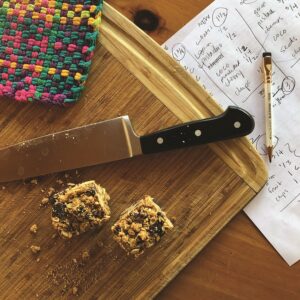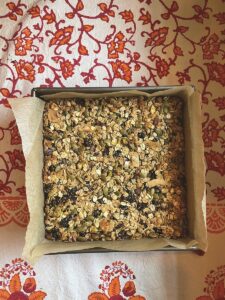This all started with Edouard Fontenot’s Indie-adapted Eleven Madison Park granola. I had to stop making it this winter because when I had it on hand it took over as my breakfast, lunch, and dinner. Its salty sweetness made it highly crave-able, and in turn it ate away at my capacity to enjoy anything else. Maybe a bar, I thought, would limit my granola consumption to snack time.
What my research first confirmed was that, despite the wonder of granola (that one especially), most store-bought granola bars don’t measure up. They’re either too sweet or too bland or too overtly protein-y, like glorified chalk. While I can appreciate a Clif Bar here or there, those big soft bars are more like a substitute for a peanut butter sandwich than anything remotely granola.

I decided to work out a homegrown combination of the flavor power of granola with the portability of a packaged bar. To get there, I experimented with three different approaches to the granola bar.
The most classic versions incorporate the traditional granola staples of almonds and dried fruit; some add toasted wheat germ for crunch. I wanted to adopt the splendid flavor palette of my favorite granola, so I opted for pistachios and dried cherries. But other combinations could be substituted: walnuts or pecans for the almonds; dried apricots or raisins instead of the cherries. The wheat germ, though — that was something new I’d adopt.
Deb Perelman, who writes Smitten Kitchen, has an elevated version I considered. Her thick, chewy granola bars are extravagant, forgoing crunchiness for the luxury of nut butter. I hadn’t thought of putting almond butter in something instead of just eating it directly off a spoon.
But if my bars were to be for snack time and not for every meal of the day, there was one other thing to consider: chocolate. Perelman has a recipe that shirks nuts and dried fruit (for the most part) in favor of coconut flakes and chocolate. Adding those to the mix would distinguish my bars from granola by making them decidedly treats. And why not?
My first experiment combined the best of everything I’d read but held off on the nut butter: I wanted crunchy, not chewy, bars. Maple syrup and salt would balance the background. I used olive oil instead of coconut oil, just because that’s one of the secrets of my granola. Just a little cinnamon made the house smell like a bakery. It yielded a gorgeous panful of ingredients.
As soon as they were cool, I cut into them, and that’s when things fell apart. Before me was a cutting board scattered with chocolate-chip granola.

A consultation with Teresa, who edits our food pages, led to the next experiment. We agreed the goal was to make the mixture stick together better without ending up with bars so gooey they would lose their crunch. Panic ensued when we read that pastry chef David Lebovitz had never found a granola bar recipe that worked. Only the fact that the failures are so good, whether pinched off the countertop or scattered over yogurt, kept us going.
We read every complaint and suggestion we could find on the issue of the too-crumbly granola bars. Should we add a mashed banana? Corn syrup? Heat the maple syrup? We went for adding almond butter and increasing the maple syrup a tad. We cut back the coconut because some bakers said it made the mixture too dry, and we gave it and the nuts a whirl in the Cuisinart, too, before adding them to the base. This got us closer to the ideal. But crumbles still outnumbered finished-looking bars.
There were two more things to try with the last of our ingredients. They were both the kind of things that patient people do, not people like us, not until now. Even though they were both things Deb Perelman and her followers were adamant about. Neither one is about the ingredients.
The first requires physical strength: you need to really press the mixture into the pan. “I mean, I use a heavy can of tomatoes and really go after it,” said one baker. Pressing the bars down again as soon as they come out of the oven isn’t overkill.
The second winning technique requires mental might: you must not cut the bars until the next day. They need to cool and spend a whole night chilling in the refrigerator to firm up completely.
Even these steps did not produce the perfect edges of a corporate bar. But we’re all about doing things differently. What we have here is a salty, not-too-sweet, lightly crunchy, tart, and chocolatey granola bar. If you can make them more perfectly, please drop us a line. We’ll get right back to you — after snack time.
Granola Bars With the Works
Makes 16 squares
1 cup rolled oats
½ cup oats whirled into a powder
½ cup toasted wheat germ
½ tsp. salt
¼ tsp. cinnamon
½ cup pistachios, chopped
½ cup unsweetened coconut flakes, chopped
½ cup unsweetened dried cherries
½ cup dark chocolate chips
¼ cup pumpkin seeds
1/3 cup maple syrup
¼ cup almond butter
¼ cup olive oil
- Preheat the oven to 350° F and line an 8-inch square baking pan with parchment paper, leaving extra so that it comes up like handles on two sides.
- Place one cup of the oats in a mixing bowl. Then use a food processor to grind the remaining half cup into a powder and add it to the bowl. Process the pistachios and coconut to chop them and add them to the bowl. Add the cherries, chocolate chips, and pumpkin seeds. Toss all these dry ingredients together well.
- In a small bowl, stir together the maple syrup and almond butter until smooth. Then pour over the dry ingredients and stir to combine well and moisten.
- Put the mixture in the baking pan and smooth out the top, pressing the mixture down tightly. Cover the top with a piece of parchment paper and use a heavy can to press the mixture even further.
- Bake for 30 minutes, until golden brown on top and slightly darker around the edges. Remove from oven and while it is hot press firmly to compact the mixture again.
- Let the pan cool, then put it in the refrigerator overnight to chill completely before slicing into 2-inch-by-2-inch bars.



